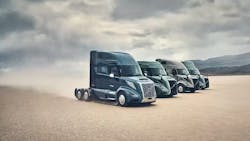While they were shy in making a big announcement about it, Volvo recently teased that they would begin selling a Class 8 electric truck with a sleeper—an electric VNL—in late 2025. Volvo was skimpy on the details of the electric VNL, so we don’t know if they are going to integrate some of the features of the diesel version or not, but it sure looks like they are working on a sleeper version of a battery-electric vehicle.
I am excited that a truck manufacturer is working to tackle electrifying the long-haul sleeper segment of trucking. So many battery electric vehicle naysayers are focused on that segment. They forget that the trucking industry is actually comprised of a variety of duty cycles. They disparage BEVs because batteries do not have the range to operate in long-haul duty cycles.
I expect Volvo to be only the first truck maker to announce plans for a Class 8 BEV. But whether other OEMs follow suit or not, I am hoping that word of an upcoming Class 8 BEV sleeper will allow for a more robust discussion of places where BEVs make sense today.
Too many people are hung up on the fact that current-model BEVs have a maximum range of about 250 miles. The reality is there are a great many applications where a 250-mile range is more than enough for a fleet to meet its delivery obligations. In recent years, we have seen the average length of haul decrease, meaning that there currently are many duty cycles where BEVs will be able to replace diesel-powered trucks.
See also: Volvo shows off how all-new VNL is designed to make fleets more green
Now, I clearly understand that very few, if any trucks with short distances need sleepers.
What I struggle with is the people who take the all-or-nothing approach to BEVs. By that I mean they believe unless BEVs work for all trucking applications, they have no place in trucking. Trucking is not a homogeneous entity. No two fleets operate the same. No two fleets spec their trucks exactly the same way. No two fleets operate in the exact same duty cycles.
According to FleetOwner’s 2023 Trucking By The Numbers, in 2022 there were 757,652 regulated carriers operating in the U.S. And here are some very interesting statistics from that article:
- 95.8% of motor carriers operate fleets of 10 or fewer trucks.
- 99.7% of motor carriers operate fleets of 100 or fewer trucks.
We have fleets that operate interstate while others operate intrastate. We have truckload carriers and less-than-truckload carriers. We have trucks operating on dedicated routes and others that operate on irregular routes. We have fleets that have van trailers and others that have reefers or flatbeds.
Trucking isn’t just one thing. I think it is time we stopped acting as if it were. Maybe the Volvo announcement is enough for those people who lump all trucking into long-haul to see that even in that market segment, work is being done to make BEVs a viable option. In the meantime, let’s continue to deploy BEVs and other clean powertrains into applications where they make sense today. Not all options need to work for every use case in order for them to be viable.
About the Author

Michael Roeth
Executive Director
Michael Roeth is the executive director of the North American Council for Freight Efficiency. He serves on the second National Academy of Sciences Committee on Technologies and Approaches for Reducing the Fuel Consumption of Medium and Heavy-Duty Vehicles and has held various positions with Navistar and Behr/Cummins.
